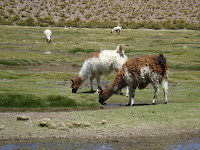
It was a long journey since S. Pedro de Atacama, so when we arrived last tuesday to Arequipa, we went to our hostel and we spent the rest of the day exploring the beautiful colonial city.
Our first impression of Peru was good.
The day after, we have visited the "Museo de la Universidad Catolica de Santa Maria" museum, where "Juanita", the frozen body of an Inca litle girl is placed. The all history behind this finding in one of the local volcanos (Ampato) is very interesting - check it out in this wikipedia entry:
Momia Juanita .

On thursday, we did a tour to the Colca canyon which is the second deepest canyon in the world. The first deepest canyon is also in the same region. We had to wake up at 2am for this tour. It was a full day tour and as the place was aprox. 3 hours from Arequipa, we needed to leave the hostel at that time.

We arrived to Chivay, a town inside the Colca Valley, at around 5:30am and had breakfast there. Our group was of 7 persons. We then left in direction to "Cruz de los Condores" where we could see the Andean Condors. On the way there, we stopped in some view points to appreciate the landscape. Amazing, how people can live in the high plateau. Our tour guide explained us how the agriculture fields were built in the montains in a way that the water could easily be distributed.

In the place for viewing the Condors, we stopped there for about 1 hour. Unfortunately, we just saw 2 condors flying aroung, but they were very high, so it was difficult to appreciate their splendor. The Andean Condor can be more than 2 meters wide. In this same place, we could appreciate the Colca Canyon deapness from the top. Incredible.

We did a small trek that accessed different view points, for a better view of the canyon.
We then went back to Chivay, where we had lunch.
On the way there, we have stoped in some local traditional villages.
It's impressive the way Peruvians work on the turism. They are too agressive and sometimes anoying, when they try to sell something. This Colca tour, even though it was very interesting for the different sceneries and history, is too turisty. In the view points, there are allways local people trying to sell their handcrafts and local products. It is all made up for the tourist. People are very friendly, though.

After lunch, we went back to Arequipa, another 3 hours. We have seen nice fauna and flora and also observed the imponent "Misti" vulcano.
We then rested for the next day's bus trip to Puno.
Friday, 8 am, we arrived by taxi to the bus terminal in Arequipa, which looks like an airport :)
We checked in our luggage, paid the "Terminal departure tax" and got in the "gate" to wait for our bus. The waiting room was the same kind as the lounge rooms in the airports. Nice confortable sofas, free internet, bar,...
We then proceed to our 6 hours bus trip to Puno.
Puno is a city, located in the margins of "Lago Titicaca" of "Titicaca Lake". This lake is the highest navigable lake in the world. It sits 3,812 m (12,500 ft) above sea level.
We stayed in a nice hostel. The owner gave us all the information we needed and lots of tips on what to do in the city and surroundings.


Saturday, we have done a tour in the Titicaca Lake. This tour included going to 2 different islands: "Islas Flotantes or Uros" and "Taquile".

The first islands are artificial. The Uros use the
totora plant to make boats (balsas mats) of bundled dried reeds as well as to make the islands themselves. Another place full of interesting history - check out the wikipedia entry for more info about
Uros. Another good example on how the Peruvians are working hard on turism, which is giving a high contribution to the local economy.


The "
Taquile" island is different. There are aprox. 800 inhabitants. They all dress with traditional local vests.
We just arrived to the island and there are plenty of little cute children. Everytime a tourist would take a picture the children come and join. Of course, after that they would ask for a contribution of normally 1 sole.
After visiting the island, we had a very nice lunch in a local restaurant. The local fish is the trout. We had it and loved it. Really tasty.
We then went back to Puno. The boat trip took another 3 hours aprox. Time to rest.
In the evening we went to a very nice dinner which included live local traditional music and dance.

Tomorrow, we'll be leaving to Cuzco where we will stay for a week.
 Between this 2 places there is a stairway "Escadaria Selaron"that is totally covered by little tiles from all over the world. Dutch, portuguese, brazilian, irish, really from everywhere!
Between this 2 places there is a stairway "Escadaria Selaron"that is totally covered by little tiles from all over the world. Dutch, portuguese, brazilian, irish, really from everywhere!
 He also makes art, paintings, and they all have the same image of a pregnant women but with his head on top :-)
He also makes art, paintings, and they all have the same image of a pregnant women but with his head on top :-)





















































